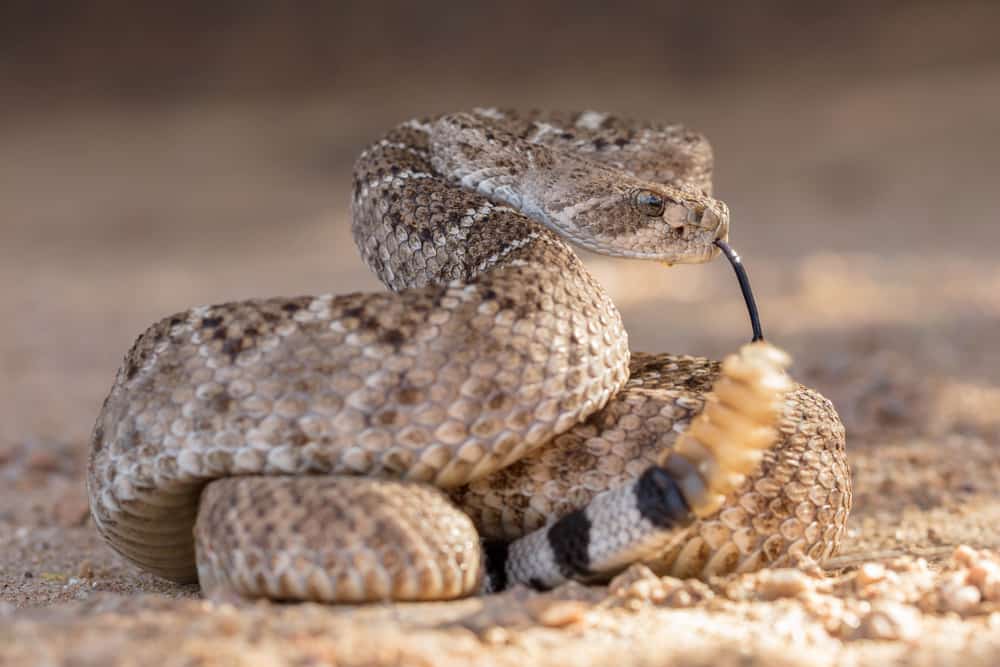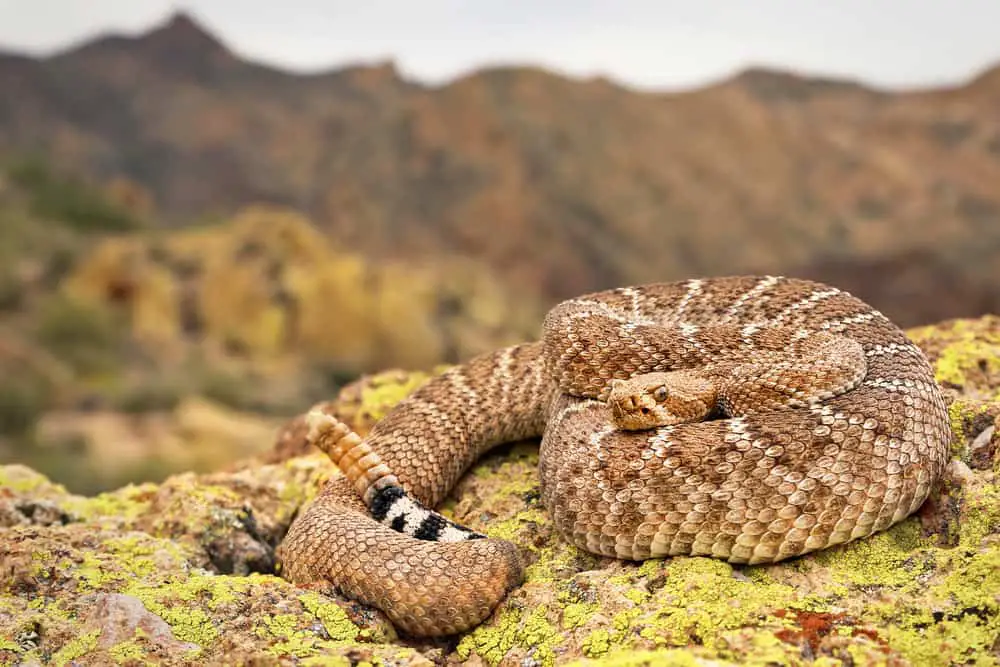The Western Diamondback Rattlesnake (Crotalus atrox) is a species of venomous pit viper found in North and Central America. It is one of the most recognizable snakes in North America due to its diamond-shaped pattern along its back, as well as the distinctive rattle at the end of its tail.
This species plays an important role in local ecosystems by preying on small mammals and helping control rodent populations. Its reputation for aggression has led to it being killed by humans out of fear or unintentionally through habitat destruction.
This article will discuss various aspects of the Western Diamondback Rattlesnakes’ biology, behavior, ecology, and conservation status. In particular, we will focus on how human activity affects this species, both directly and indirectly. We will also explore potential solutions that can be taken to ensure that these impressive reptiles are able to thrive within their natural habitats.
Overall, this article seeks to provide readers with an understanding of why protecting these animals is so essential not only for their own survival but also for maintaining healthy wildlife communities throughout much of western North America.

Overview
The western diamondback rattlesnake is one of the most widely distributed and recognizable venomous snakes in North America. Found primarily in arid, rocky habitats across the southwestern United States, Mexico, and Central America, this species has adapted notable traits to thrive in its environment.
The snake’s namesake rattle consists of a series of interlocking keratin segments that produce an audible warning when agitated or threatened. Additionally, they are equipped with two large venom glands located near the head which secrete hemotoxic venom through long hollow fangs used for hunting prey and warding off predators.
Western diamondback rattlesnakes belong to the family Viperidae, within which there are over 250 extant species. Crotalus atrox is thought to be closely related to other members of the genus Crotalus such as C. viridis (the prairie rattlesnake) due its similar size and coloration characteristics.
Other than the distinctive patterning on their bodies, C. atrox can also be distinguished from other snake species by their more robust tail section containing several enlarged plates called subcaudal scales followed by 3-9 rattles depending upon age and condition respectively.
In terms of behavior patterns, western diamondbacks are primarily diurnal animals during hot summer months but become nocturnal as temperatures decrease in colder regions. This adaptability enables them to maximize energy efficiency while reducing exposure time to potential threats like humans or competing carnivores. In optimal environments these reptiles tend to live solitary lives until mating season begins where males may engage in competitive behaviors prior to courtship rituals with females.
Habitat And Range
The Western Diamondback Rattlesnake is mainly found in the desert areas of southwestern United States. It thrives in rocky terrains, such as plains and scrublands with sparse vegetation. This species also inhabits grassland prairies, open woodlands, dry stream beds and arid regions near mountain foothills.
Within its habitat range, this species typically lives on sandy or rocky hillsides or flats which provide ample cover from predators. The Western Diamondback Rattlesnake can be found in a variety of habitats including creosote bush covered deserts, pine-oak forests, semiarid chaparrals and riparian corridors along streams within the southwest United States.
They are most abundant in drier parts of their range where they prefer more open areas rather than dense shrubbery to hunt for prey.
Western Diamondback Rattlesnakes often take shelter under rocks during the day but may become active during sunny days when temperatures reach up to 80 degrees Fahrenheit. During colder weather or periods of drought, these snakes will seek refuge underground in animal burrows or holes made by pocket gophers and ground squirrels.
Consequently, many individuals hibernate communally in large dens consisting of hundreds to thousands of rattlesnakes during winter months when food sources have dwindled. In conclusion, the Western Diamondback Rattlesnake has adapted to live successfully across various terrain types throughout its vast habitat range across southwestern USA.
Physical Description
The Western Diamondback Rattlesnake is a venomous pit viper species. It has a triangular-shaped head and body, with diamond-patterned coloration in light brown to grayish-white hues. On average, adult specimens of the species measure between 30 – 60 inches in length.
Its scales are keeled and its pupils oval shaped, giving it excellent eyesight for hunting prey both day and night. The rattlesnake’s tail ends in a rattle composed of modified scales that produce sound when vibrated by muscular contractions – an adaptation used as a warning signal against predators or intruders. Furthermore, this species is equipped with retractable fangs connected to glands containing hemotoxic venom which can be injected into potential prey items or threats alike.

Diet And Hunting Habits
The western diamondback rattlesnake primarily feeds on small mammals, such as mice and rats. They have also been known to consume birds, lizards, frogs, and even other snakes. This species can be found hunting in any open area or near rocky outcrops during the day. At night they favor more low-lying areas where their prey is likely to be abundant.
Western diamondbacks use ambush tactics when hunting their prey. These powerful snakes are capable of striking with considerable speed and accuracy; they may strike up to two-thirds of their body length away from them. In addition to ambushing their prey, these rattlesnakes will sometimes actively search for food by flipping over rocks or investigating burrows in the ground.
Overall, the diet of a western diamondback consists mainly of rodents, but it may vary depending on what type of prey is available in its environment. As cold-blooded predators, they need less energy than warm-blooded animals so they eat only every few weeks or months depending upon their success at catching prey and the availability of food sources.
Protecting Poultry: How to Keep Snakes Away
Reproduction And Life Cycle
The western diamondback rattlesnake, Crotalus atrox, is a species of venomous pit viper found in the southwestern United States and parts of Mexico. Reproduction and life cycle stages for this species are interesting to observe due to its unique behavior during mating season.
Reproduction:
*Mating Season:
The reproductive season begins late summer and continues through early fall. During this time, males may travel long distances looking for mates while females remain stationary as they attract nearby males with their pheromones.
*Gestation Period:
After successful reproduction, female western diamondbacks typically gestate offspring for six months before giving birth to up to twenty live young in mid-summer. Newborns measure approximately 20 centimeters in length and are immediately capable of hunting small prey such as lizards or rodents using their venomous bite.
*Life Cycle Stages:
Western diamondback rattlesnakes reach sexual maturity between three and four years old when they have reached an average size range of 60-90 cm in length. They can continue breeding until about 10-15 years old after which most individuals die from natural causes or predation by other animals such as coyotes or birds of prey. Adults lead solitary lives but may congregate together in certain areas during cooler temperatures throughout the year.
Overall, western diamondback rattlesnakes demonstrate many varying behaviors associated with their life cycle stages that make them a fascinating species of wildlife to study further under controlled conditions for herpetologists and wildlife biologists alike.
Interactions With Humans
The Western diamondback rattlesnake is a species of venomous snake found in North America and is among the most dangerous to humans. Human-rattlesnake encounters are common, particularly during warm weather when they become active. Rattlesnakes usually only bite if provoked or threatened; however, it is important for individuals to take caution when encountered with one as its bite can be lethal.
Rattlesnake bites typically cause immediate pain and swelling at the affected area, followed by tingling sensations that spread throughout the body. Severe symptoms may include dizziness, nausea, vomiting and difficulty breathing.
\Treatment requires prompt medical attention where antivenom is administered intravenously within four hours following the bite, otherwise severe tissue damage will occur and result in death. In addition to administering antivenom, doctors may apply pressure bandages or ice packs on the bitten area to reduce further absorption of the venom into neighboring tissues.
To avoid human-rattlesnake encounters people should be aware of their surroundings while outdoors and wear protective clothing such as boots and long pants especially in areas known for their presence. People also should not handle unfamiliar snakes even if they appear dead since some still possess reflexes after dying which could lead them to biting out of instinctual defense mechanisms.
Conservation Status
The western diamondback rattlesnake is a species of venomous snake native to North America. It is listed as Least Concern on the IUCN Red List, however, due to its declining population in certain areas and fragmentation of habitats throughout its range, it is considered threatened or endangered in some states. Conservation efforts are being carried out through research and habitat protection in order to protect this species from further decline.
Research conducted by wildlife biologists has been important for gaining insight into the ecology and conservation status of the western diamondback rattlesnake. This includes studies assessing impacts of urbanization on populations, effects of climate change on their habitats, and threats posed by human activities such as hunting, collecting for pet trade, road mortality and accidental killing due to fear or ignorance.
The data obtained from these surveys have helped inform conservation strategies that can be used to support long-term management plans for this species.
Protection of suitable habitats across their range will be critical for ensuring successful recovery and persistence of the western diamondback rattlesnakes.
Efforts should include creating protected reserves at strategic locations where they occur most frequently; developing better land use policies that discourage development near known rattlesnake dens; promoting responsible recreational activities such as hiking which help minimize disturbance around den sites; and providing education about the importance of preserving wild places for both humans and reptiles alike.
By implementing effective conservation measures along with ongoing monitoring programs, we can ensure that future generations can continue to enjoy encountering these fascinating creatures in their natural environment.
Conclusion
The western diamondback rattlesnake is a species native to North America. It has adapted well to various environments, ranging from coastal prairies and woodlands to deserts and mountains. Its body is covered with distinctive diamond-shaped markings that range in color from light brown to grayish black, while its rattle serves as an effective warning system against potential predators.
The diet of the western diamondback consists mostly of rodents, lizards, frogs and birds, which it hunts by utilizing a combination of its strong senses of smell and sight. Reproduction typically occurs every two years, during which females will give birth between 5-17 live young.
Human interaction with this species can be both beneficial and detrimental; however it is important for us to understand their importance within our ecosystems so we may properly protect them.
Although they are not listed as endangered or threatened under any federal acts in the U.S., populations have decreased drastically due to overhunting and habitat destruction throughout much of its historical range. As such, conservation efforts should focus on protecting existing habitats through land management plans that limit human activity and promote healthy ecosystems for these animals to thrive in.
In conclusion, the western diamondback rattlesnake plays an essential role in maintaining ecological balance within many parts of North America. While there are risks associated with interactions between humans and this animal, understanding their behavior patterns allows us to coexist peacefully whilst still respecting their place within nature’s delicate web of life.
Conservation measures must be taken now if we wish to ensure future generations will be able to appreciate the beauty of this majestic creature in its natural environment for years to come.

